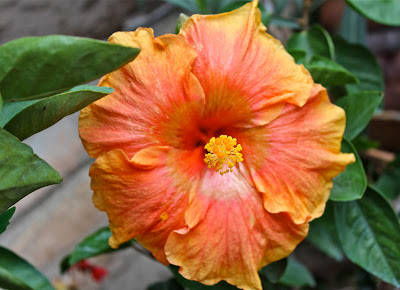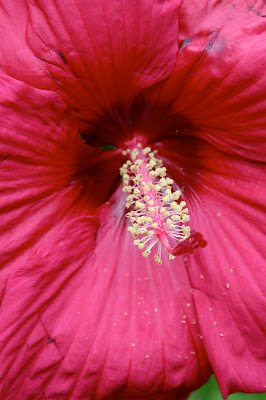This morning's tomato harvest. The fruit is coming on strong now, but thanks to the CSA, I have been able to keep up pretty well so far. No infestations of fruit flies yet!
The big heritage tomatoes are starting to ripen. Here are five Brandywines from this morning next to a teaspoon for scale. Each of these tomatoes is over a pound, but not nearly as big as our record Gold Medal tomato that was over 2 pounds.
The dense tomato jungle, heavy with fruit, collapsed the center section of my cattle fence, so now the fencing is strung up to the ceiling and tied taut to the walls of the high tunnel. Next year I will know to tie it to the ceiling from the very beginning so the tomatoes can be clipped higher for support. I have tied them up as high as I can reach, about 8 feet, but they would go much higher if I had stretched them up before they became such a heavy tangle. At this point, I am going to clip off any new growth. There are many fruits yet to ripen, and I need to get those plants out in a few weeks to get in the winter crops. I intend to direct seed the other half of the high tunnel next week, and I guess I will have to start seeds in flats to transplant to where the tomatoes are.
Unfortunately, I have developed a sensitivity to tomato plants, getting an itchy rash between my fingers, on my wrists, and wherever the foliage brushes against me. So now I try to wear long sleeves when I work in there, spray Benadryl gel on my arms and hands before harvesting, and take a shower right after harvesting. At least it isn't an allergic reaction to eating tomatoes--that would be tragic!
The big heritage tomatoes are starting to ripen. Here are five Brandywines from this morning next to a teaspoon for scale. Each of these tomatoes is over a pound, but not nearly as big as our record Gold Medal tomato that was over 2 pounds.
The dense tomato jungle, heavy with fruit, collapsed the center section of my cattle fence, so now the fencing is strung up to the ceiling and tied taut to the walls of the high tunnel. Next year I will know to tie it to the ceiling from the very beginning so the tomatoes can be clipped higher for support. I have tied them up as high as I can reach, about 8 feet, but they would go much higher if I had stretched them up before they became such a heavy tangle. At this point, I am going to clip off any new growth. There are many fruits yet to ripen, and I need to get those plants out in a few weeks to get in the winter crops. I intend to direct seed the other half of the high tunnel next week, and I guess I will have to start seeds in flats to transplant to where the tomatoes are.
Unfortunately, I have developed a sensitivity to tomato plants, getting an itchy rash between my fingers, on my wrists, and wherever the foliage brushes against me. So now I try to wear long sleeves when I work in there, spray Benadryl gel on my arms and hands before harvesting, and take a shower right after harvesting. At least it isn't an allergic reaction to eating tomatoes--that would be tragic!
























































